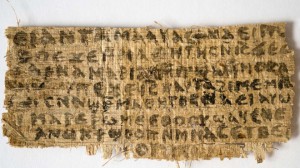 Remember the Jesus’s wife papyrus fragment that had liberals and womenpriest wannabes all in a flutter? HERE.
Remember the Jesus’s wife papyrus fragment that had liberals and womenpriest wannabes all in a flutter? HERE.
I saw this at First Things:
Gospel of Jesus’ Wife: Forgery Confirmed?
Thursday, October 11, 2012
Anna Williams
In the weeks since Harvard historian Karen King unveiled the papyrus fragment dubbed “The Gospel of Jesus’ Wife,” evidence rapidly mounted that the scrap could be a forgery. The latest discovery: The fragment, which contains snippets from the Coptic text of the Gospel of Thomas, replicates a small error found in an online version of that text.[…]
Go here for the rest of Goodacre’s post and here for Bernhard’s full argument.
It must be realllly hard to be a forger these days, what with the internet and real scholars out there and everything.
See ya, Mrs. Jesus!


































Very good work. My initial reaction to the manuscript “discovery” was: (1) as far as I can tell, Christianity doesn’t fall apart if Jesus had a wife, but (2) if so, it’s incredible that we never heard a word about her until now, and (3) Coptic discoveries don’t always hold up well (remember The Gospel of Judas)?
Oh you’re a little behind on this news Fr Z. After the divorce she met a nice lady from Ephesus, travelled (by camel this time) to Tiberius’ court where the Pharisees were lobbying for gay “marriage” and were not quite sure because the page was torn but it looks like “Mary’s wife” . Seriously you have got to keep up!
Too soon for the gift registry list to be discovered.
Really interesting and not unsuspected.
Here at the Western Dominican Province house of studies in Oakland, I transcribed the fragment when it first appeared and gave a copy to a Dominican deacon brother who knows Coptic and other ancient languages. After a quick glance, he said: “This text has weird grammatical errors. I would guess it was a forgery of some kind, unless there is an unknown dialect of Coptic used for Gnostic texts until now unknown.”
am glad I heard the news first from a student brother in our house of studies. Nice that the academics are now reaching the same conclusions!
Really interesting and not unsuspected.
Here at the Western Dominican Province house of studies in Oakland, I transcribed the fragment when it first appeared and gave a copy to a Dominican deacon brother who knows Coptic and other ancient languages. After a quick glance, he said: “This text has weird grammatical errors. I would guess it was a forgery of some kind, unless there is an unknown dialect of Coptic used for Gnostic texts until now unknown.”
I am glad I heard the news first from a student brother in our house of studies. Nice that the academics are now reaching the same conclusions!
Satisfying news!
Fr Your previous comment thread had a link to a conference from a graphologist whose analyis of the magnified brushstrokes was very convincing circumstantial evidence of forgery – all only hours after the news broke!
Modern Spectroscopy can use very small samples indeed , which again, any large proportions of any element or compound never before found in antiquity , but abundant today,would be telling if not definitive.(small proportions could come from contamination-you keep something aeons old in a a plastic bag, you can find traces of what the bag’s made of). But If I were a forger, I d use genuinely old papyrus and scrape geninely old ink or wash off other papyruses of or egyptian monuments or scraès off similar for analysis in labs already, and ,wetted with triple distilled water , reapply. I hope someone in a path. lab doesn’t say any more too publicly, the less forgers know of how they are detectable by other modern methods, the better! I know a country where , not too sub rosa, nor all that far from Egypt, “Fossil factories “. exist.
I don’t know how large a sample of both papyrus and ink would need destroying for radiocarbon dating: technical discussions of the shroud should be insight on the problems , especially of contamination Humans sweat and breathe, and bugs breed, all adiing modern carbon.
I suspect we shall never get more than one extremely suspicious circumstance after another. Enough for a jury conviction in a murder case? – well ok, OJ simpson, etc. How about a will? would you award a multimillion dollar inheritance to someone on this sort of evidence?
This one never passed the ‘smell test’. When the crucial words appear to have been written in a different shade of ink (or a sharpie marker) and the document has no provenance, all you’ve got is some ambitious academic trying to make a splash at a conference, with a feminist axe to grind, and a complicit media running with the story.
What passes for scholarship (and journalism) these days is frightening. The blogosphere is having to do their work for them.
Fr. Thompson, tell your deacon “Good catch.” Even though he knows it.
mike cliffson, go immediately and read Kipling’s short story “Dayspring Mishandled”. It’s right on point, with an ending that’s simultaneously terrifying and redemptive.
Interesting; it means the supporting correspondence in German must also have been forged since that predates the internet. Or maybe there was a hard copy of that Coptic Thomas that was earlier than 1997 on which the forgery was based. Or maybe the error just isn’t that rare…
Forgery or not, this document is in no way proof the historical Jesus had a wife, as even Dr King has said.
False information can be called back in by merely producing proof of forgery? Oh, would that it were so simple as that!